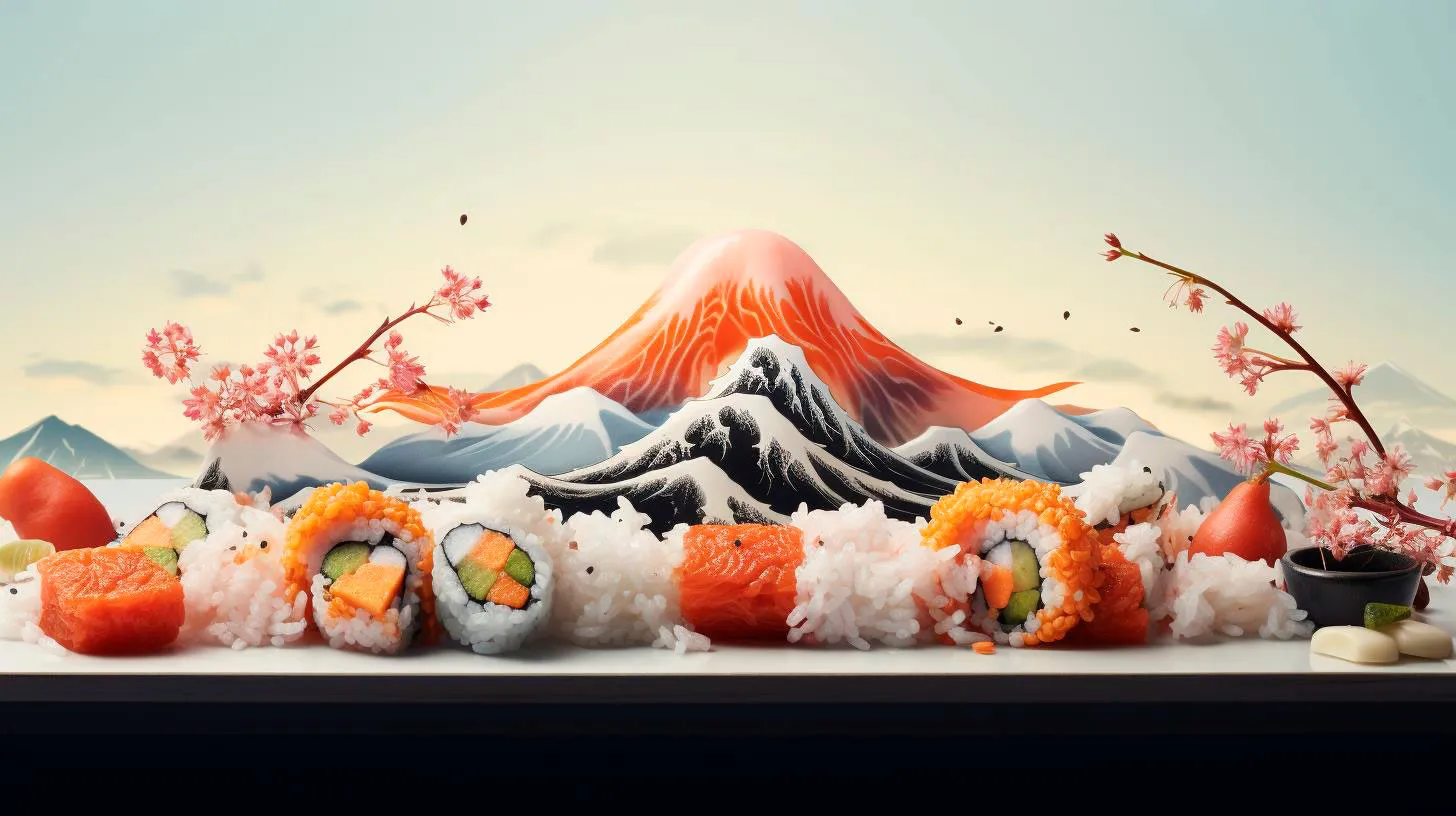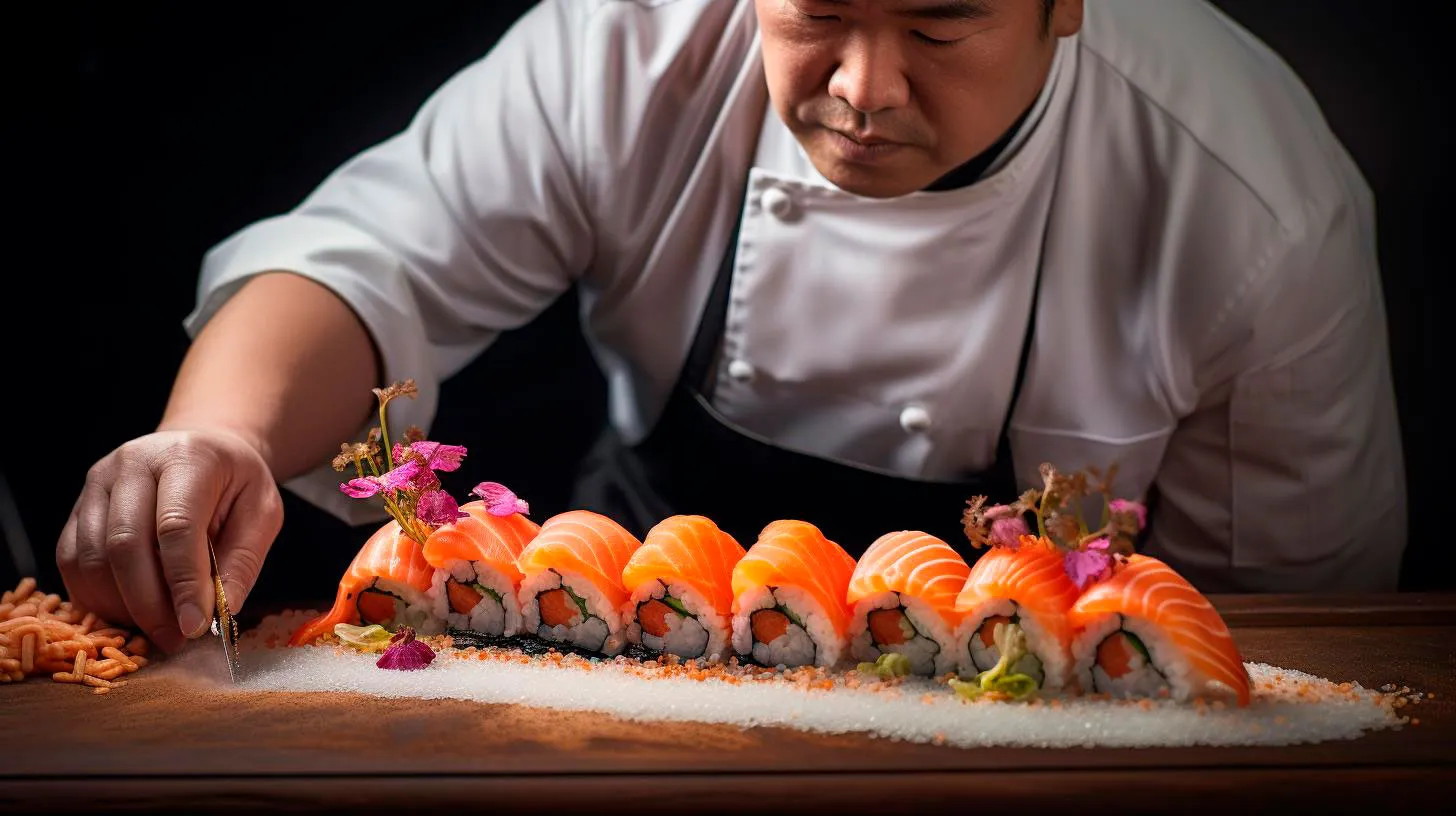Bold and Healthy: Embracing Unconventional Ingredients in Okinawan Sushi
Okinawa, the southernmost prefecture of Japan, has its own unique culture and cuisine. Its food is known for promoting longevity and overall well-being. By incorporating distinct local ingredients into sushi, Okinawan chefs have created a refreshing and nutritious twist on this timeless dish.
Unconventional Ingredients: Opening Up a World of Flavors
Okinawan sushi incorporates a variety of unconventional ingredients, tantalizing taste buds with surprising flavors:
-
Bitter Melon
Bitter melon, or “goya” as it is called in Okinawa, is a popular ingredient used in local dishes due to its numerous health benefits. This vegetable is rich in vitamins and minerals, low in calories, and may contribute to lowering blood sugar levels. Incorporating thinly sliced goya into sushi adds a refreshing bitterness that complements other ingredients perfectly, providing a unique and healthy twist.
-
Sea Grapes
Known as “umibudo” in Japanese, sea grapes are small seaweed pearls that burst with a juicy texture and a salty taste. Packed with minerals and nutrients, these translucent green beads are a delightful addition to any sushi roll. With their resemblance to tiny grapes, they not only enhance the aesthetics of the dish but also add a burst of flavor and a pleasant crunch.
-
Local Herbs
The abundance of fresh herbs in Okinawa allows chefs to experiment with unique flavor combinations. Herbs like purple perilla, or “beni-shiso,” offer a refreshing and peppery taste that complements the traditional elements of sushi. Adding a few leaves of these aromatic herbs introduces a burst of color, aroma, and an invigorating twist to the sushi experience.
-
Pork Tamago
Unlike traditional sushi, Okinawan sushi occasionally features cooked meat. Pork tamago is a mouthwatering combination of slow-cooked and marinated pork belly served with a sweet scrambled egg. The tenderness of the pork beautifully balances the sweetness of the egg, resulting in a harmonious savory flavor that sets Okinawan sushi apart from its counterparts.
The Advantages of Embracing Unconventional Ingredients
By incorporating unconventional ingredients into their sushi creations, Okinawan chefs offer numerous advantages for both the culinary experience and personal wellness:
-
Expanded Flavor Palette
The use of unconventional ingredients provides an entirely new dimension of flavors, elevating the sushi experience to unparalleled levels. From the bitterness of goya to the burst of sea grapes, each ingredient contributes unique tastes that intrigue and delight the taste buds.
-
Health Benefits
Many of these unconventional ingredients boast exceptional health benefits. Bitter melon aids in blood sugar regulation, while sea grapes offer essential nutrients and minerals such as calcium, iodine, and magnesium. By incorporating these ingredients, Okinawan sushi becomes a health-conscious choice for those seeking a balanced and nutritious meal.
-
Visual Appeal
The vibrant colors and visual appeal of Okinawan sushi make it a feast for the eyes. The addition of purple perilla, for example, adds an attractive pop of color, while the sea grapes lend an elegant touch with their translucent green appearance. The careful presentation of these ingredients enhances the overall dining experience, making it as visually appealing as it is delicious.
-
Cultural Appreciation
Okinawan sushi allows diners to delve into the cultural heritage of the region. By embracing these unconventional ingredients, food enthusiasts gain a deeper understanding and appreciation for Okinawan cuisine and its vibrancy. It serves as a testament to the rich gastronomic traditions preserved and celebrated in the region.
Key Takeaways
Okinawan sushi is a bold and healthy twist on the traditional delicacy. By incorporating unconventional ingredients like bitter melon, sea grapes, local herbs, and pork tamago, chefs unleash a plethora of distinctive flavors that tantalize the taste buds and promote well-being. Embracing these ingredients offers expanded flavor palettes, health benefits, visual appeal, and an opportunity to appreciate Okinawan culture. So, step out of your comfort zone and experience the world of Okinawan sushi – a delicious and enriching journey for your senses!
From Sea to Table: Discovering the Sustainable Sushi Practices of Okinawa
In this article, we will delve into the sustainable sushi practices of Okinawa and uncover the key factors that make it a standout in the culinary world.
The Importance of Sustainable Sushi
Before we dive into the specifics of Okinawa’s sustainable sushi practices, let’s take a moment to understand the significance of sustainability in the sushi industry. Overfishing and unsustainable fishing practices have led to a decline in global fish populations, threatening the delicate balance of marine ecosystems. It is crucial for sushi lovers and industry professionals to promote sustainable practices to ensure the longevity of this beloved cuisine.
Now, let’s explore the sustainable sushi practices that make Okinawa a role model for other regions to follow:
1. Locally Sourced Ingredients
Okinawa’s sushi chefs prioritize using locally sourced ingredients, maximizing freshness and reducing carbon footprint associated with transportation. By relying on local fishermen and seasonal produce, they establish a direct connection between the sea and the table, showcasing the diversity and abundance of the region’s seafood.
Key Takeaway: Supporting local fishermen and utilizing seasonal ingredients allows for a more sustainable sushi experience with lower environmental impact.
2. Traditional Fishing Methods
In Okinawa, traditional and low-impact fishing methods are embraced, with an emphasis on maintaining the delicate balance of marine ecosystems. Instead of large-scale trawlers, local fishermen utilize traditional methods such as handline fishing or pole-and-line fishing, which are less destructive to the environment and reduce bycatch.
Key Takeaway: By using traditional fishing methods, Okinawa ensures that its sushi production remains environmentally friendly, supporting the long-term health of its marine ecosystems.
3. Responsible Aquaculture
A significant portion of the seafood used in Okinawa’s sushi is sourced from responsible aquaculture facilities. These facilities prioritize the well-being of the fish and adhere to sustainable farming practices. By engaging in responsible aquaculture, Okinawa reduces the pressure on wild fish populations, promoting a more balanced and sustainable approach to sushi production.
Key Takeaway: Responsible aquaculture plays a crucial role in meeting the increasing demand for seafood while minimizing the impact on natural habitats.
4. Educating Consumers
Okinawa recognizes the importance of educating consumers about sustainable sushi practices. Many sushi restaurants in the region actively inform their customers about the environmental impact of their choices and encourage them to make informed decisions. This awareness helps foster a culture of sustainability among sushi enthusiasts, creating a positive ripple effect throughout the industry.
Key Takeaway: By educating consumers, Okinawa empowers sushi lovers to make conscious choices that support sustainable practices, ensuring a better future for the sushi industry as a whole.
The Results
Okinawa’s dedication to sustainable sushi practices has not gone unnoticed. In recent years, the region has gained recognition as a sustainable seafood destination. The Michelin Guide has highlighted Okinawa’s sushi restaurants for their commitment to quality and sustainability, making it a must-visit for sushi lovers.
Key Statistics:
- Overfishing has led to a decline in global fish populations, with 33% of fish stocks being exploited and 60% fully fished.
- By 2050, it is estimated that virtually all commercial fish stocks will be overexploited, fully exploited, or have collapsed.
- Responsible aquaculture currently provides 50% of the world’s seafood consumption.
In conclusion, Okinawa’s sustainable sushi practices serve as an inspiring example for the entire industry. By prioritizing locally sourced ingredients, embracing traditional fishing methods, engaging in responsible aquaculture, and educating consumers, Okinawa has created a sushi culture that not only tantalizes taste buds but also protects our oceans for future generations. So, the next time you embark on a culinary adventure, consider indulging in the sustainable sushi delights of Okinawa!
Tradition meets innovation: Unveiling the unique techniques of Okinawan sushi chefs
In this article, we will delve into the world of Okinawan sushi chefs and uncover the secrets behind their unmatched culinary skills.
The Okinawan approach: Innovating while preserving tradition
Okinawa, known for its rich cultural heritage and breathtaking landscapes, also boasts a distinctive culinary tradition. Okinawan sushi chefs take the art of sushi making to new heights by incorporating innovative techniques without compromising the essence of traditional sushi.
Here are some unique techniques employed by Okinawan sushi chefs:
- Agar-based sushi rice: In Okinawa, chefs often use agar, a natural jelly-like substance derived from seaweed, to shape sushi rice into delicate and intricate designs. This not only enhances the visual appeal of the dish but also adds a subtle layer of flavor.
- Local ingredients: Okinawan sushi chefs take full advantage of the island’s abundant resources, using locally sourced and seasonal ingredients to create their masterpieces. From fresh tuna to unique local seaweeds, the ingredients used in Okinawan sushi offer a distinct flavor profile.
- Creative fillings: While traditional sushi often features classic fillings such as raw fish, Okinawan sushi chefs are known to experiment with a variety of non-traditional ingredients. From marinated tofu to braised pork belly, the fillings used in Okinawan sushi provide a burst of unexpected flavors.
- Artistic plating: Okinawan sushi chefs pay meticulous attention to the presentation of their dishes. They artfully arrange the sushi on the plate, often incorporating vibrant colors and intricate designs, transforming each plate into a visual masterpiece.
The advantages of Okinawan sushi techniques
Okinawan sushi techniques offer several advantages that set them apart from traditional sushi-making methods:
- Enhanced visual appeal: The use of agar-based sushi rice and artistic plating techniques elevate the visual appeal of Okinawan sushi, making it a feast for the eyes as well as the taste buds. This can greatly enhance the dining experience and leave a lasting impression on customers.
- Expanded flavor palette: By incorporating a wide range of local and seasonal ingredients, Okinawan sushi chefs introduce diners to unique and unexpected flavors. This provides an opportunity for culinary exploration and adds an element of surprise to each bite.
- Creative expression: Okinawan sushi chefs have the freedom to experiment with different techniques and ingredients, allowing them to express their creativity and individuality through their sushi creations. This results in a diverse and dynamic sushi scene in Okinawa.
- Tourist attraction: The fusion of tradition and innovation in Okinawan sushi has become a significant draw for tourists. Visitors from around the world flock to Okinawa to experience the unique flavors and artistic presentation of this innovative sushi style.
Key takeaways
Okinawan sushi chefs have managed to strike a perfect balance between preserving tradition and embracing innovation. By incorporating agar-based sushi rice, local ingredients, creative fillings, and artistic plating, they have elevated sushi-making to an art form.
Remember these key takeaways from the Okinawan approach to sushi:
- Agar-based sushi rice adds visual appeal and a subtle layer of flavor.
- Using local and seasonal ingredients introduces unique flavors.
- Creative fillings provide unexpected taste experiences.
- Artistic plating elevates the dining experience.
- The fusion of tradition and innovation attracts tourists.
So, the next time you enjoy a piece of sushi, take a moment to appreciate the skill and ingenuity of the Okinawan sushi chefs who continuously push the boundaries of this revered culinary art.
Reviving Ancient Flavors: Exploring Okinawan Influences on Sushi
This article will delve into the unique influences from the Okinawan culture that have contributed to the revival of ancient flavors in sushi.
The Rich Cultural Heritage of Okinawa
Okinawa, a beautiful archipelago located in southern Japan, has a fascinating cultural heritage that sets it apart from the rest of the country. Over the centuries, Okinawa had historical connections to various East Asian countries, such as China and Korea. These influences have not only shaped Okinawan traditions but have also made their way into the island’s cuisine, including sushi.
Here are some key features and advantages of Okinawan sushi:
- Distinctive Ingredients: Okinawan sushi relies heavily on local ingredients that showcase the island’s unique flavors. Sea grapes, a type of seaweed only found in Okinawa, add a refreshing burst of umami to the sushi.
- Health Benefits: Okinawan cuisine is renowned for its health benefits, with Okinawans having one of the highest life expectancies in the world. The use of fresh fish, locally sourced vegetables, and minimal use of oil make Okinawan sushi a nutritious choice.
- A Blend of Flavors: The fusion of Okinawan, Japanese, and Chinese flavors creates a harmonious blend that is both pleasing to the palate and rich in cultural heritage.
- Traditional Techniques: Okinawan sushi masters meticulously follow traditional techniques, ensuring that the flavors and presentation are on par with the region’s proud sushi-making history.
Key Takeaways from Okinawan Sushi
Okinawan sushi offers a unique and refreshing twist on traditional Japanese sushi, providing a delightful culinary experience. Here are some key takeaways:
- Reviving Ancient Flavors: Okinawan sushi enables us to discover and savor the ancient flavors that have been passed down through generations, preserving a rich culinary heritage.
- Diversifying Sushi Options: Exploring Okinawan influences encourages sushi enthusiasts to expand their palate and try something new, adding more variety to their sushi experience.
- Cultural Appreciation: By embracing Okinawan sushi, we gain a deeper understanding and appreciation of the diverse cultural influences that shape Japanese cuisine.
- Health-Conscious Choice: Opting for Okinawan sushi allows us to enjoy a delicious meal while reaping the health benefits associated with this style of cuisine.
Industry Statistics
Here are some fascinating statistics that highlight the growing popularity of sushi:
- In the United States alone, sushi restaurants generate over $2 billion in revenue annually.
- According to a survey, sushi is the third most popular ethnic cuisine among Americans, following only Italian and Mexican food.
- The global sushi market is estimated to reach a value of $22 billion by 2025.
- Approximately 45% of Americans have tried sushi at least once.
In conclusion, Okinawan influences have breathed new life into the fascinating world of sushi. The distinctive ingredients, traditional techniques, and cultural blend make Okinawan sushi a standout among the various regional styles of Japan. So the next time you visit a sushi restaurant, consider embracing the flavors of Okinawa and embark on a culinary journey that connects you to the ancient roots of this beloved dish.



